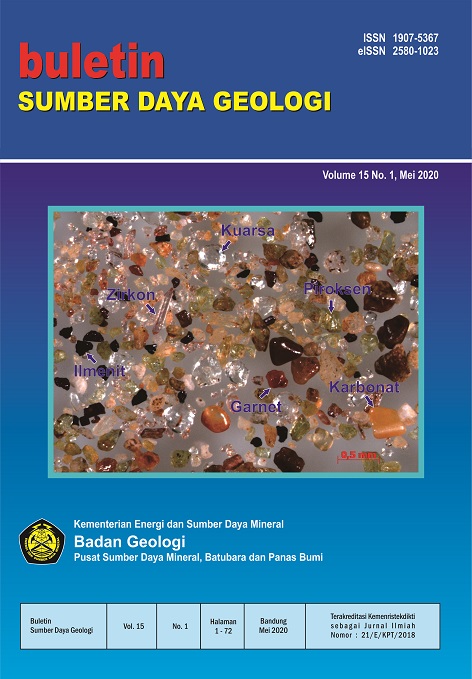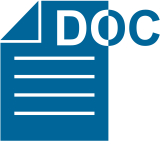ANALISIS UNIVARIAT DAN MULTIVARIAT CONTO SEDIMEN SUNGAI DALAM PENENTUAN POTENSI MINERALISASI LOGAM DI HALMAHERA BAGIAN TIMUR, PROVINSI MALUKU UTARA
UNIVARIATE AND MULTIVARIATE ANALYSIS OF STREAM SEDIMENT SAMPLE FOR DETERMINATION OF METAL MINERALIZATION POTENTIAL IN THE EASTERN PART OF HALMAHERA, NORTH MALUKU
Abstract
Geochemical research used the analysis method of -80 mesh of active stream sediment samples is one of the early phase exploration specially in finding out metallic mineral deposits. Easternpart of Halmahera with its complex geologic setting and a metallogenic region is being potential to form metallic deposits, which create some variation and interesting geochemical performances. The geochemistry of stream sediment data by means in the form of elements distribution maps represent the basic important information of mineralization indications, which enable for detail follow up research, specifically nickel mineralization associated with the Ultrabasa Complex lithology.
Interpretation of geochemical data in the study area with univariate and multivariate statistical analysis approaches consisting of elements of Cu, Pb, Zn, Co, Ni, Mn, Ag, Fe, Cr, and Au, the process of enrichment of geochemical elements in the surface environment is shown by the spatial association of Co, Ni, Fe and Mn, namely the enrichment of elements due to chemical binding (scavenging) by Fe and Mn oxides. Based on the kindship of elements or relations between elements obtained two groups of elements, namely the bonding elements of Cu-Pb-Zn-Ag-Cr and Co-Ni-Mn-Fe-Au, but not all groups of element associations can be related to the lithology that develops in the study area.
Downloads
References
Apandi, T. dan Sudana, D., 1980, Peta Geologi Lembar Ternate, Maluku Utara Skala 1 : 250.000. Pusat Penelitian dan Pengembangan Geologi, Bandung, Direktorat Jendral Geologi dan Sumberdaya Mineral, Departemen Pertambangan dan Energi.
Fadhly, A., Syafri, I., dan Abdurrokhim, 2017, Zonasi anomali unsur geokimia di Weda, Kabupaten Halmahera Tengah, Maluku Utara berdasarkan data univariat dan multivariat, Bulletin of Scientific Contribution, Volume 15, Nomor 3, hlm. 243-254.
Faisal, R., Soepriadi, Rosana, M., dan Yuningsih, E., 2015, Analisis Faktor dan Univariat Dalam Penentuan Potensi Mineralisasi Cu, Pb, Zn di Halmahera Bagian Barat, Maluku Utara, Buletin Sumber Daya Geologi, Volume 10 Nomor 3, halaman 167-183.
Faisal, R., dan Mauritz, J., 2018, Survei Geokimia Regional Bersistem Lembar Ternate A-5, Pulau Halmahera, Provinsi Maluku Utara. Pusat Sumber Daya Mineral Batubara dan Panas Bumi, Badan Geologi, Kementerian Energi dan Sumber Daya Mineral.
Ghazali, S. A., Muchjidin, dan Hariwidjaja, 1986, Penyelidikan Geokimia Endapan Sungai: Metode dan Teknik. Direktorat Sumber Daya Mineral, Bandung.
Karypis, G., Han, E., dan Kumar, V.,1999, Chameleon: hierarchical clustering using dynamic modeling. IEEE Computer, Vol. 32, Issue 8, Aug 1999.
Levinson, A. A., 1980, Introduction to Exploration Geochemistry. Edisi Kedua. Applied Publishing, Illinois.
Rose, A. W., Hawkes, H. E., dan Webb, J. S., 1979, Geochemistry in Mineral Exploration. Edisi Kedua. Academic Press, London.
Surjadi, P. A., 1976, Pendahuluan Teori Kemungkinan dan Statistika. Penerbit ITB, Bandung.
Swan, A. R. H. and Sandilands, M., 1995, Introduction to Geological Data Analysis, Blackwell Science Ltd., Oxford.
Copyright (c) 2020 Buletin Sumber Daya Geologi

This work is licensed under a Creative Commons Attribution-NonCommercial-ShareAlike 4.0 International License.
Authors whose manuscripts are published agree to the following terms:
The publication rights of all journal manuscript materials published on the Buletin Sumber Daya Geologi website are held by the editorial board with the knowledge of the author (moral rights remain with the manuscript’s author).
The formal legal provisions for access to digital articles in this electronic journal are subject to the terms of the Creative Commons Attribution-ShareAlike (CC BY-SA) license. This means that Buletin Sumber Daya Geologi has the right to store, convert media/formats, manage in the form of a database, maintain, and publish the article without requesting permission from the author, as long as the author’s name is cited as the copyright holder.
Manuscripts published in both print and electronic formats are open access for educational, research, investigative, and library purposes. Beyond these purposes, the editorial board is not responsible for any violations of copyright law.















